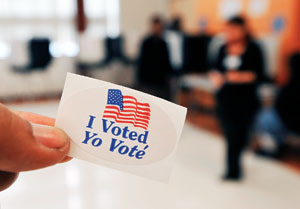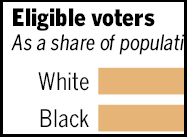CQ WEEKLY – VANTAGE POINT
June 4, 2011 – 8:23 a.m.
A Rough Estimación: Statistics on Hispanic Voters Aren’t So Simple
By Niels Lesniewski, CQ Staff
As the Hispanic population of the United States grows rapidly, so too does the debate over its political effect.

|
||
|
The latest talking point is research, released by a think tank that favors low immigration, that says there wasn’t much of an effect at all last November. The Center for Immigration Studies (CIS) says the immigration issue did not bring Hispanics out to vote in greater numbers, nor did it cause them to stay home. And it says Hispanics, along with the rest of the electorate, were more likely to vote Republican in 2010 than in 2008.
The Washington-based center cites exit polls from House races that showed an 8-point increase in the share of the Hispanic vote that went to Republicans, part of the wave that gave the GOP control of the House.
“If the failure to address immigration played a role in Hispanic voting, it seems to have helped Republicans,” CIS researchers Steven A. Camarota and Ashley Webster wrote in a memo last month.
However, Matt A. Barreto, an associate professor of political science at the University of Washington and director of the Washington Institute for the Study of Ethnicity and Race, says the entire premise of the CIS study is wrong. It runs counter to the results in individual races, he says.
“The most important takeaway from the 2010 election,” Barreto wrote, “was that it represented a very large increase in the Democratic vote share among Hispanics. This bucked the national trend in which more voters swung to the GOP. Among Hispanics, this was absolutely not the case, and in fact, it was a record-high vote for the Democrats.”
Barreto’s research group, Latino Decisions, says numbers in the exit poll don’t square with what happened in races such as the one for a Nevada Senate seat, where beleaguered Democrat
Barreto says Angle’s stated positions on immigration issues probably generated opposition among Hispanic voters. Reid, meanwhile, aggressively courted Hispanics and promised to hold a post-election Senate vote (as he eventually did) on the measure to provide legal status for some illegal immigrants who came to the United States as children. The bill was known as the DREAM Act.

|
||
|
Latino Decisions says polls of Latino voters are flawed. Notably, they chide the consortium conducting the exit poll for not having enough Spanish-speaking survey takers and for not having enough Spanish-language surveys — the implication being that a disproportionate share of Hispanics who show up in exit polls are those who are fluent in English.
Latino Decisions conducted a bilingual telephone poll on election eve that estimated that 90 percent of Nevada Latinos would vote for Reid, compared with the 68 percent reported by the exit poll.
The gap in results demonstrates the difficulty in accurately polling the population, something that had been identified as a problem after the 2004 election. The problem can only grow in significance as the voting-age population of Latinos increases.
A Rough Estimación: Statistics on Hispanic Voters Aren’t So Simple
But these bottom-line numbers don’t tell the whole story, because the overall Latino turnout continues to increase.
The CIS estimated the Latino share of the vote nationally at 6.9 percent, based on a joint survey by the Bureau of Labor Statistics and the Census Bureau. The center says that percentage fits the pattern, but that the line is moving upward. The Pew Hispanic Center released its own analysis noting that the same figure is an increase from 5.8 percent in 2006 and from 5.1 percent in 2002.
CIS notes that the share of Latino voters nationwide is relatively modest because so many people who identify as Hispanics in census surveys are either younger than 18 or not U.S. citizens, making them ineligible to vote.
Mark Lopez, associate director of the Pew Hispanic Center, says the percentage of eligible Latino voters in off-year elections doesn’t increase as much because of the demographics of the large number of newly eligible voters. “Many of the new voters are younger,” he says, in the 18-25 age group, which traditionally has lower voter turnout in midterm elections, regardless of ethnic background or origin.
As these voters age, their turnout will be likely to increase, making them more important moving forward.